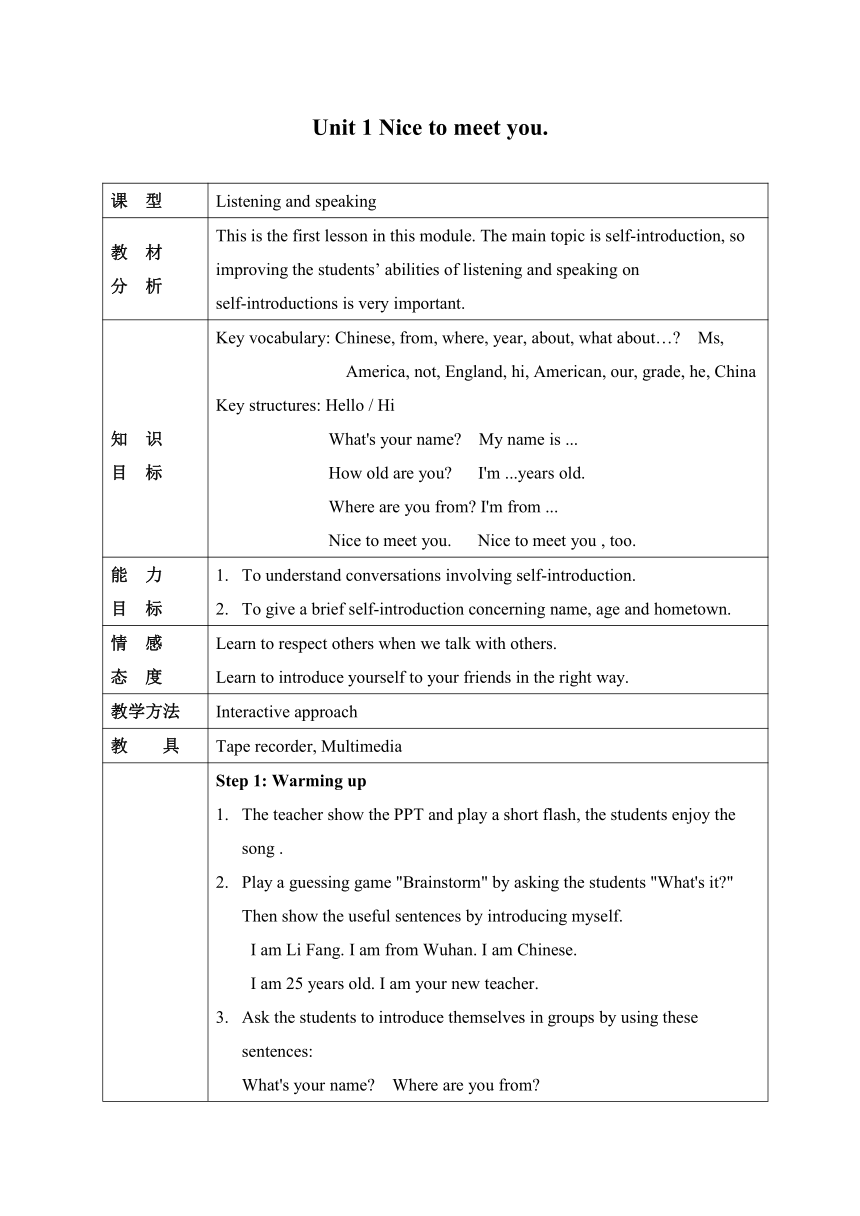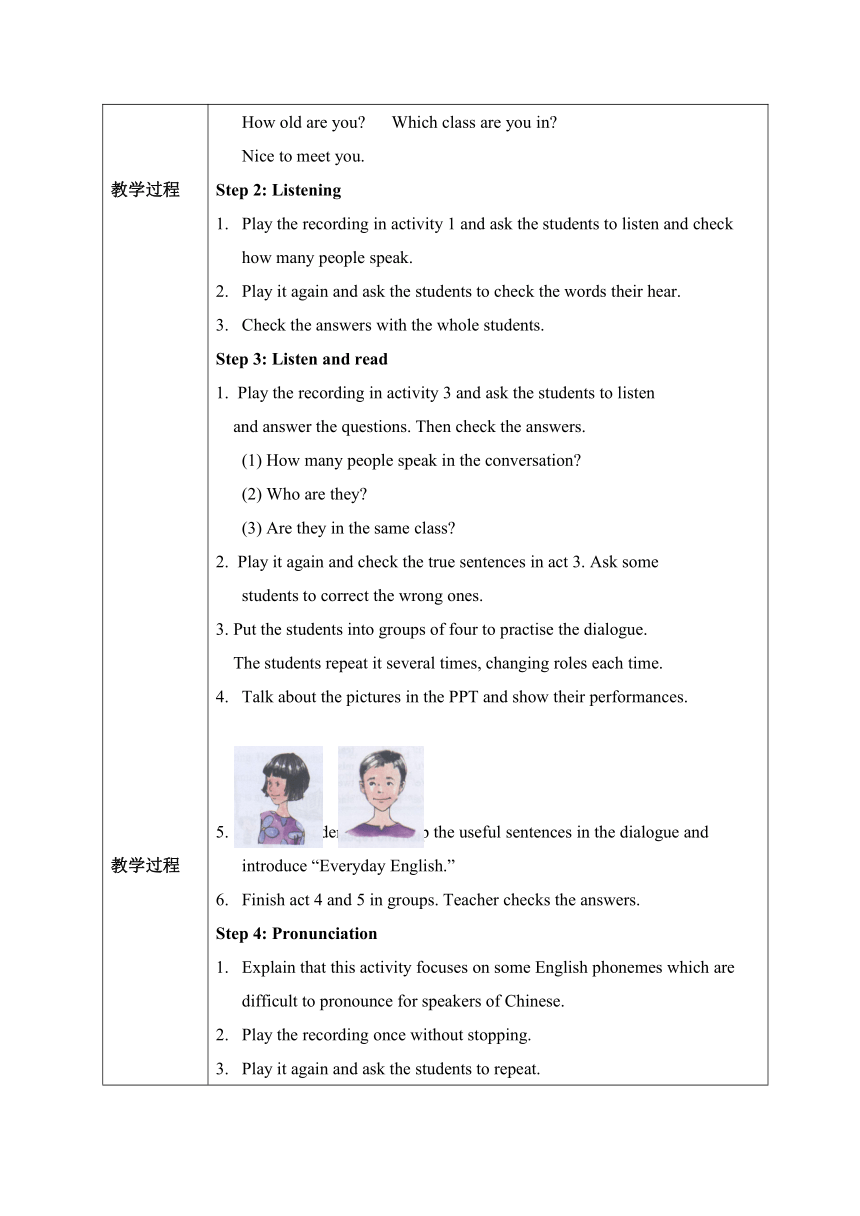Unit 1 Nice to meet you.教案
文档属性
| 名称 | Unit 1 Nice to meet you.教案 |  | |
| 格式 | zip | ||
| 文件大小 | 121.7KB | ||
| 资源类型 | 教案 | ||
| 版本资源 | 外研版 | ||
| 科目 | 英语 | ||
| 更新时间 | 2012-12-17 19:04:25 | ||
图片预览


文档简介
Unit 1 Nice to meet you.
课 型
Listening and speaking
教 材
分 析
This is the first lesson in this module. The main topic is self-introduction, so improving the students’ abilities of listening and speaking on self-introductions is very important.
知 识
目 标
Key vocabulary: Chinese, from, where, year, about, what about…? Ms, America, not, England, hi, American, our, grade, he, China
Key structures: Hello / Hi
What's your name? My name is ...
How old are you? I'm ...years old.
Where are you from? I'm from ...
Nice to meet you. Nice to meet you , too.
能 力
目 标
To understand conversations involving self-introduction.
To give a brief self-introduction concerning name, age and hometown.
情 感
态 度
Learn to respect others when we talk with others.
Learn to introduce yourself to your friends in the right way.
教学方法
Interactive approach
教 具
Tape recorder, Multimedia
教学过程
教学过程
教学过程
教学过程
教学过程
教学过程
Step 1: Warming up
The teacher show the PPT and play a short flash, the students enjoy the song .
Play a guessing game "Brainstorm" by asking the students "What's it?"
Then show the useful sentences by introducing myself.
I am Li Fang. I am from Wuhan. I am Chinese.
I am 25 years old. I am your new teacher.
Ask the students to introduce themselves in groups by using these sentences:
What's your name? Where are you from?
How old are you? Which class are you in?
Nice to meet you.
Step 2: Listening
Play the recording in activity 1 and ask the students to listen and check how many people speak.
Play it again and ask the students to check the words their hear.
Check the answers with the whole students.
Step 3: Listen and read
Play the recording in activity 3 and ask the students to listen
and answer the questions. Then check the answers.
(1) How many people speak in the conversation?
(2) Who are they?
(3) Are they in the same class?
Play it again and check the true sentences in act 3. Ask some
students to correct the wrong ones.
3. Put the students into groups of four to practise the dialogue.
The students repeat it several times, changing roles each time.
Talk about the pictures in the PPT and show their performances.
Ask the students to sum up the useful sentences in the dialogue and introduce “Everyday English.”
Finish act 4 and 5 in groups. Teacher checks the answers.
Step 4: Pronunciation
Explain that this activity focuses on some English phonemes which are difficult to pronounce for speakers of Chinese.
Play the recording once without stopping.
Play it again and ask the students to repeat.
Practise the sounds in pairs, then finish the exercises on the PPT.
Step 5: Speaking
Talk about the pictures by asking and answer in paris like this:
A: What’s his name?
B: His name is….
A: Where is he from?
B: He's from….
A: How old is he?
B: He's ...years old.
Step 6: Module task
Task 1: Who has the most friends?
运用本课句型,在规定的八分钟时间内,以小组为单位,看谁结交的朋友最多,她将获得一份丰厚的奖品。
Task 2: Introduce yourself by using today's useful sentences.
Step 7: Language points
1. I’m from Wuhan. 我来自武汉。(我是武汉人。)
Be from 表示“来自哪里”、“从哪里来”或“是哪里人”。如:
He’s from Beijing. 他来自北京。(他是北京人。)
They’re from England. 他们来自英国。(他们是 英国人。)
如果不强调从哪里来,只是要说明身份,也可以说:
He’s a Beijinger. 他是北京人。
They’re English. 他们是英国人。
2. Where+is/are+主语+from?
英语中,通常用特殊疑问句"Where + is / are + 主语+ from?"来询问某人"来自哪里","是哪里人",其答语通常用"主语+ am / is / are from + 地点"。如:
—Where is Sam from?
萨姆从哪里来?
—He is from England.
他来自英国。
拓展:be from = come from,如:
Where do you come from?
Where does he come from?
3. What’s your name?
英语中,当想知道对方叫什么名字时,可用句型"What’s your name?"进行询问,其答语一般用"My name is + 姓名."。如:
—What’s your name?
你叫什么名字?
—My name’s Gao Jing.
我叫高晶。
拓展:当你想很有礼貌地问别人的名字时,你可以这样问:
What’s your name, please?
May I have your name, please?
4. I’m twelve years old. 我12岁。
…years old,表示“……岁”。有时候years old 可以省略,只用数字来表达年龄即可。如:Her dog is three. 她的小狗3岁。
拓展:对该句型提问可用:How old ...?它是英语中一个较重要的句型,主要用来询问某 人的年龄,其答语通常用"主语+ am / is / are + 年龄."。如:
—How old are you? 你多大了?
—I am thirteen (years old).我十三岁。
5. Nice to meet you . 很高兴见到你!
这是两位初次见面相识后的用语,意思是“见到你很高兴。”见面相识可由自我介绍,第三者介绍或者询问相识。例如:
—Hello!I'm Xiao Hua.
—Hello!I'm Xiao Li.
—Nice to meet you, Xiao Li.
—Nice to meet you, too, Xiao Hua.
6. What about you? 你呢?
英语中“What about...?”是一句常用的客套 话,它后面可接名词、代词或动名词(ing)形式,它的功能可不少呢!
(1)询问或打听消息。如:
I'd like a cup of tea. What about you?
我想喝杯茶,你呢?
(2)向对方提出建议或请求。如:
What about playing football now?
现在踢足球怎么样?
(3)寒暄时的问候语,有承上启下的转折作用,如:
I'm a student from China. What about you?
我是一名来自中国的学生,你呢?
7. Welcome to Class 4, Grade 7. 欢迎来到七年级四班。
welcome to ...欢迎来到...,这是一句欢迎用语,在英语中使用比较广泛,如:
Welcome to Beijing! 欢迎来北京。
Welcome, come in,please. 欢迎,欢迎,请进来。
Step 8: Consolidation
Do some exercises and check with the whole class.
Step 9: Homework
板书设计
Module 1 Unit 1
What’s your name? My name is…
Where are you from? I’m from…
Nice to meet you, … Nice to meet you, too.
作业布置
1. Finish off the workbook exercises.
2. Make your favourite "English name card".
教学反思
The students can talk in English.
课 型
Listening and speaking
教 材
分 析
This is the first lesson in this module. The main topic is self-introduction, so improving the students’ abilities of listening and speaking on self-introductions is very important.
知 识
目 标
Key vocabulary: Chinese, from, where, year, about, what about…? Ms, America, not, England, hi, American, our, grade, he, China
Key structures: Hello / Hi
What's your name? My name is ...
How old are you? I'm ...years old.
Where are you from? I'm from ...
Nice to meet you. Nice to meet you , too.
能 力
目 标
To understand conversations involving self-introduction.
To give a brief self-introduction concerning name, age and hometown.
情 感
态 度
Learn to respect others when we talk with others.
Learn to introduce yourself to your friends in the right way.
教学方法
Interactive approach
教 具
Tape recorder, Multimedia
教学过程
教学过程
教学过程
教学过程
教学过程
教学过程
Step 1: Warming up
The teacher show the PPT and play a short flash, the students enjoy the song .
Play a guessing game "Brainstorm" by asking the students "What's it?"
Then show the useful sentences by introducing myself.
I am Li Fang. I am from Wuhan. I am Chinese.
I am 25 years old. I am your new teacher.
Ask the students to introduce themselves in groups by using these sentences:
What's your name? Where are you from?
How old are you? Which class are you in?
Nice to meet you.
Step 2: Listening
Play the recording in activity 1 and ask the students to listen and check how many people speak.
Play it again and ask the students to check the words their hear.
Check the answers with the whole students.
Step 3: Listen and read
Play the recording in activity 3 and ask the students to listen
and answer the questions. Then check the answers.
(1) How many people speak in the conversation?
(2) Who are they?
(3) Are they in the same class?
Play it again and check the true sentences in act 3. Ask some
students to correct the wrong ones.
3. Put the students into groups of four to practise the dialogue.
The students repeat it several times, changing roles each time.
Talk about the pictures in the PPT and show their performances.
Ask the students to sum up the useful sentences in the dialogue and introduce “Everyday English.”
Finish act 4 and 5 in groups. Teacher checks the answers.
Step 4: Pronunciation
Explain that this activity focuses on some English phonemes which are difficult to pronounce for speakers of Chinese.
Play the recording once without stopping.
Play it again and ask the students to repeat.
Practise the sounds in pairs, then finish the exercises on the PPT.
Step 5: Speaking
Talk about the pictures by asking and answer in paris like this:
A: What’s his name?
B: His name is….
A: Where is he from?
B: He's from….
A: How old is he?
B: He's ...years old.
Step 6: Module task
Task 1: Who has the most friends?
运用本课句型,在规定的八分钟时间内,以小组为单位,看谁结交的朋友最多,她将获得一份丰厚的奖品。
Task 2: Introduce yourself by using today's useful sentences.
Step 7: Language points
1. I’m from Wuhan. 我来自武汉。(我是武汉人。)
Be from 表示“来自哪里”、“从哪里来”或“是哪里人”。如:
He’s from Beijing. 他来自北京。(他是北京人。)
They’re from England. 他们来自英国。(他们是 英国人。)
如果不强调从哪里来,只是要说明身份,也可以说:
He’s a Beijinger. 他是北京人。
They’re English. 他们是英国人。
2. Where+is/are+主语+from?
英语中,通常用特殊疑问句"Where + is / are + 主语+ from?"来询问某人"来自哪里","是哪里人",其答语通常用"主语+ am / is / are from + 地点"。如:
—Where is Sam from?
萨姆从哪里来?
—He is from England.
他来自英国。
拓展:be from = come from,如:
Where do you come from?
Where does he come from?
3. What’s your name?
英语中,当想知道对方叫什么名字时,可用句型"What’s your name?"进行询问,其答语一般用"My name is + 姓名."。如:
—What’s your name?
你叫什么名字?
—My name’s Gao Jing.
我叫高晶。
拓展:当你想很有礼貌地问别人的名字时,你可以这样问:
What’s your name, please?
May I have your name, please?
4. I’m twelve years old. 我12岁。
…years old,表示“……岁”。有时候years old 可以省略,只用数字来表达年龄即可。如:Her dog is three. 她的小狗3岁。
拓展:对该句型提问可用:How old ...?它是英语中一个较重要的句型,主要用来询问某 人的年龄,其答语通常用"主语+ am / is / are + 年龄."。如:
—How old are you? 你多大了?
—I am thirteen (years old).我十三岁。
5. Nice to meet you . 很高兴见到你!
这是两位初次见面相识后的用语,意思是“见到你很高兴。”见面相识可由自我介绍,第三者介绍或者询问相识。例如:
—Hello!I'm Xiao Hua.
—Hello!I'm Xiao Li.
—Nice to meet you, Xiao Li.
—Nice to meet you, too, Xiao Hua.
6. What about you? 你呢?
英语中“What about...?”是一句常用的客套 话,它后面可接名词、代词或动名词(ing)形式,它的功能可不少呢!
(1)询问或打听消息。如:
I'd like a cup of tea. What about you?
我想喝杯茶,你呢?
(2)向对方提出建议或请求。如:
What about playing football now?
现在踢足球怎么样?
(3)寒暄时的问候语,有承上启下的转折作用,如:
I'm a student from China. What about you?
我是一名来自中国的学生,你呢?
7. Welcome to Class 4, Grade 7. 欢迎来到七年级四班。
welcome to ...欢迎来到...,这是一句欢迎用语,在英语中使用比较广泛,如:
Welcome to Beijing! 欢迎来北京。
Welcome, come in,please. 欢迎,欢迎,请进来。
Step 8: Consolidation
Do some exercises and check with the whole class.
Step 9: Homework
板书设计
Module 1 Unit 1
What’s your name? My name is…
Where are you from? I’m from…
Nice to meet you, … Nice to meet you, too.
作业布置
1. Finish off the workbook exercises.
2. Make your favourite "English name card".
教学反思
The students can talk in English.
同课章节目录
- Starte
- Module 1 My teacher and my friends
- Module 2 My English lesson
- Module 3 My English book
- Module 4 My everyday life
- Module 1 My classmates
- Unit 1 Nice to meet you.
- Unit 2 I'm Wang Lingling and I'm thirteen years ol
- Unit 3 Language in use.
- Module 2 My family
- Unit 1 Is this your mum?
- Unit 2 These are my parents.
- Unit 3 Language in use.
- Module 3 My school
- Unit 1 There are thirty students in my class.
- Unit 2 The library is on the left of the playgroun
- Unit 3 Language in use.
- Module 4 Healthy food
- Unit 1 We've got lots of apples.
- Unit 2 Is your food and drink healthy?
- Unit 3 Language in use.
- Module 5 My school day
- Unit 1 I love history.
- Unit 2 We start work at nine o'clock.
- Unit 3 Language in use.
- Revision module A
- Module 6 A trip to the zoo
- Unit 1 Does it eat meat?
- Unit 2 The tiger lives in Asia.
- Unit 3 Language in use.
- Module 7 Computers
- Unit 1 How do I write my homework on the computer?
- Unit 2 When do you use a computer?
- Unit 3 Language in use.
- Module 8 Choosing presents
- Unit 1 I always like birthday parties.
- Unit 2 She often goes to concerts.
- Unit 3 Language in use.
- Module 9 People and places
- Unit 1 We're enjoying the school trip a lot.
- Unit 2 They're waiting for buses or trains.
- Unit 3 Language in use.
- Module 10 Spring Festival
- Unit 1 Are you getting ready for Spring Festival?
- Unit 2 My mother's cleaning our houses and sweepin
- Unit 3 Language in use.
- Revision module B
